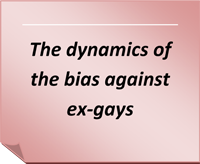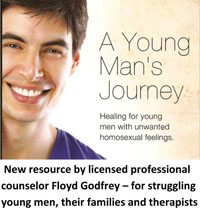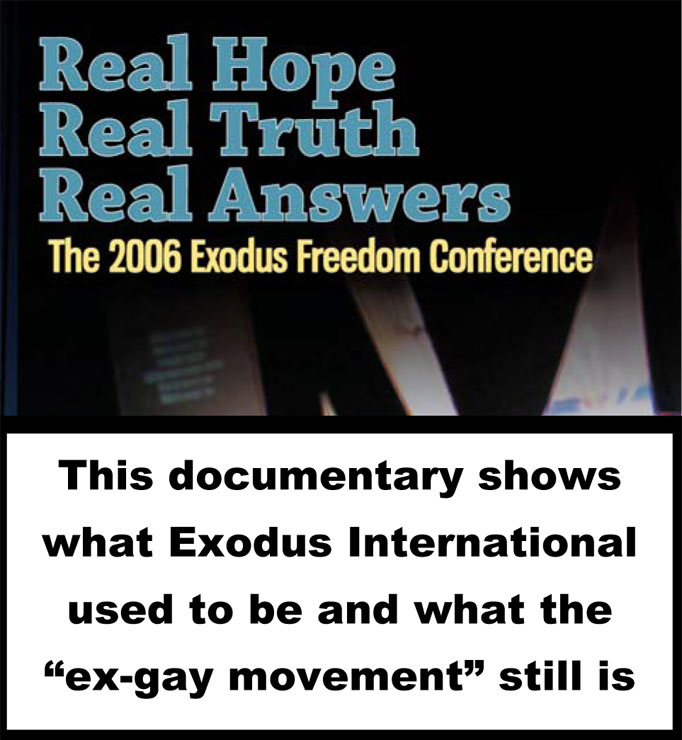James Wimbush
Source:
Compiled by Thomas Coy from James Wimbush’s testimony at the 2006 Exodus Freedom Conference.
Born:
Family Status:
Married Teresa in 2008.
General Information:
James Wimbush works with the Exodus ministry Bridge of Hope in Columbus, Ohio.
Personal Testimony:
James Wimbush’s path into homosexuality began at age five when he was “severely molested by a neighborhood boy.” The molestation continued almost daily for close to two years. As with most male child molestation the young James “hated it and … liked it at the same time.” When the neighborhood boy was caught molesting James his parents pressed charges and the neighborhood boy did jail time.
James’ parents made the mistake of letting James go to neighbor’s house to play with the brothers and sisters of the young man who molested him. The siblings taunted James telling him that it was his fault their brother molested him. They told James that he wanted their brother to sexually molest him. The young James felt dirty and guilty.
It wasn’t long before another young man sexually exploited James. This time it was the babysitter, a “friend of the family.” He would send the other children out to play and then sexually abused James. As a result of his sexual abuse James started “engaging in homosexual behavior as early as the third grade.” James was confused about sex. He did not know that what heterosexual sex was, but he was experienced in homosexual sex.
James was an outcast from his male peers in middle school and ended up playing with the girls where he was accepted. In high school his sexual abuse was a “dreadful burden.” He suffered in silence wondering, “Who could I tell? Who could I talk too? Who would understand?” The male adolescents James began hanging out with seemed to be dealing with the same sexual identity crises. James wanted to feel like his male peers that seemed secure in their masculine identity and were attracted to girls, “but it wasn’t happening.” His unwanted same-sex attractions were strong and he had not chosen them.
In college James suppressed his same-sex attractions. AIDS had begun to ravage the gay community and he “was scared to death.” James had heard that AIDS was “God’s judgment on homosexuals, and since I was homosexual, I thought AIDS and HIV was my fate.”He had “bought into the lie ‘once gay, always gay.’” After college James “led a double life,” keeping his homosexual escapades in his “secret closet.”
The gay life was anything but gay for James. His life was “empty, purposeless, and void.” In addition, he had always had the “dream to love a woman, be a father, and have a family,” and that dream was slipping away. Because of that anxiety he sought counseling and was told by the counselor to accept his homosexuality and “learn how to live with it.”
At the age of thirty-three James Wimbush had a religious conversion that radically changed his life. He had marginally identified as a Christian going to church a few times a year like at Christmas and Easter, but in his search for purpose he had actually come “to know Jesus” through the Bible and encouragement from other Christians. His journey to manhood and a purposeful life began with a “Lord and Savior relationship” with Jesus.
God through the Bible and specific individuals helped James break down the ideals that the American culture had taught him about being a man. He began to see the ideal manhood in Jesus and sought to grow into that ideal. James described this process, “See, I was born a male, but I had to choose to be a man of God. I had to choose to take back my manhood, my manhood which is rightfully mine.”
James took back his manhood. His identity is first and foremost that of a man of God. He submitted to God’s transformational process and became a heterosexual man of God. His marriage to Teresa in 2008 was the beginning of a lifelong dream. James works through Bridge of Hope ministries to help others overcome homosexuality through God’s transformational process.
Factors of Causation:
James Wimbush’s childhood is a painful memory. While his testimony does not give insight to the relationship he had with his father and mother, the sexual abuse confused the young James in many ways and made unhealthy neurological imprints of pleasure in his brain. The young James learned to associate male friendship with homosexual behavior. At no time in his childhood, adolescence, or early adulthood did James learn non-sexual male closeness. At no time did he feel like he was part of the heterosexual male world. No male secure in his own male identity nurtured him into a male identity.
Motivation to Change:
James Wimbush’s motivation to change was twofold. James had a dream of loving a wife and being a father, and, second, the gay identity and lifestyle left him feeling “empty, purposeless, and void.” James chose to be a man of God and to take back his manhood.
Personal Change Process:
James religious conversion was the means to achieve his two motives to change. His “Lord and Savior relationship” with Jesus gave him purpose and identity. It was also the foundation for his journey to heterosexuality. James’ testimony did not give details of that change process except to say that it “was a long, arduous process.”
One thing that is clear in James’ testimony is his lament that the information of sexual orientation change was not available to him in high school or from the counselor he went to as an adult. James wanted to understand his unwanted same-sex attractions in high school, he wanted to talk about his childhood sexual abuse, he would have liked to have known sexual orientation could be changed, but there was no support system to help him. The fact that James’ same-sex attractions were unwanted and that his counselor did not inform him that sexual orientation change was possible defines this particular period of history. James went through his crisis when individuals with unwanted same-sex attractions were purposely misled by so-called professionals to appease a gay political base.
Copyright 2010




